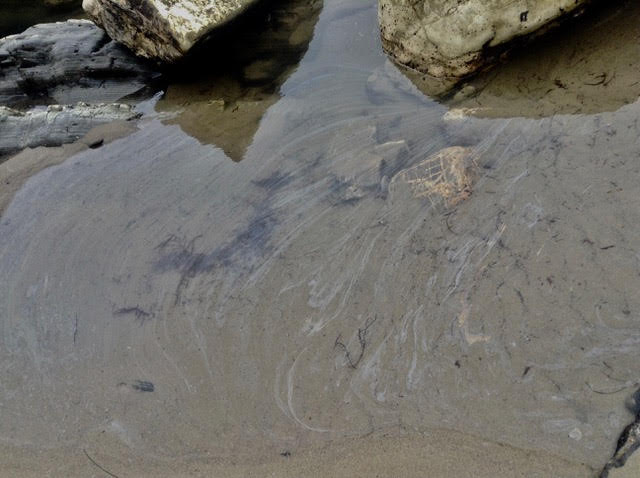By an edhat reader,
Here is a photo taken (6/03/19) of a tide pool located approximately two miles east of the site of the recent Haskell’s Beach oil spill. You can see the streaks of oil coating the surface of this tide pool. Please be aware if you’re thinking of walking the beach anywhere near the site, you will need to wear your “tar” shoes. Do not take your dog. There are the (typical of the area) “lacy” waves of thin and tiny bits of tar at the tide line and up the beach. However, what is not so typical are the larger globs of tar everywhere. Everywhere. It was sad to see the oily tide pools and incoming tide streaked with oil. Fortunately, my friends and I encountered no dead or dying oiled seabirds.





I grew up in the area and plenty of times i got out of the water from surfing in the 80’s and was covered in oil blobs, it’s natural seepage.
While it is possible this oil came from the Haskell’s spill the more likely scenario it’s from what’s commonly known as natural seepage. 100 years ago much of the coastline was carpeted with oil derricks and when the oil deposits were depleted the wells were abandoned and sometimes capped with nothing more than a telegraph/telephone pole. Anyone with experience in the coastal waters hereabouts is very familiar with the oil sheens and clumping that come and go with the seasons and tides.
Is this at Coal Oil Point? I’ve played in those tidepools for years and never really saw oil like this. That is a bummer!
This poster clearly says that this amount of oil is different that what they are used to seeing on that beach. It then seems more likely that what was seen was a result of the spill rather than some random process. But if you are in favor of fossil fuel extraction in our County then I guess you can reconfigure the facts to suit yourself.
Also worth noting to me was it was reported that only 3 sea birds were found oiled and were cleaned and released. However 2 days ago a fellow birder posted photos of an oiled and deceased Rhinoceros Auklet, an uncommon pelagic that was found just east of Haskells. Never seen one this heavily oiled from any natural seepage.
We were at a beach north of SB this weekend. I have been going to local beaches in this area for over 4 decades. While there has always been tar on the beach, I have never seen as much as I did this weekend. Not even after the Refugio oil spill was cleaned up. Couldn’t help to think that the Haskells oil spill had something to do with it.
I read a report of a study by Woods Hole and UCSB that said that the natural seepage offshore of Goleta was 25 tons per day. 50 thousand lbs. , 275 lbs per barrel of crude, is about 182 barrels daily.
Not so sure who is reconfiguring the facts. I’m in the ocean of Goleta more than most people (3-4x week). Oil sheens and blobs come and go. They are part of life. I highly doubt there’s any connection between anything 2mi from where no more that 120gal were spilled. Since you’re interested in facts: 10,000 gallons seep naturally into the channel off Goleta EVERY DAY. The little spill at Haskells amounts to 1% of daily seepage. Good thing there was such a rush to clean that up. Don’t put me down as being in favor of oil spills, but no need to make a crisis out of something that’s not.